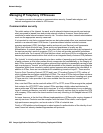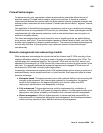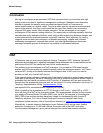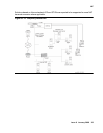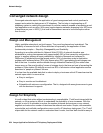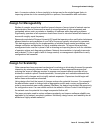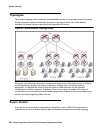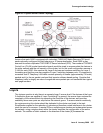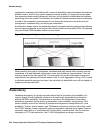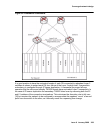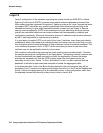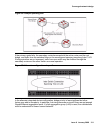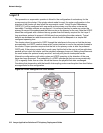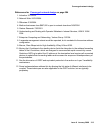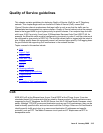
Network design
308 Avaya Application Solutions IP Telephony Deployment Guide
configuration complexity with little benefit in terms of availability unless the subnets terminate on
different routers, which in turn implies separate modular clusters. An argument can be made
that separate subnets simplify diagnostic activities, but this benefit is achievable with address
partitioning within the subnet. Port densities for smaller full featured routers may be inadequate
to scale to the connectivity requirements of even this small cluster when the extra ports for
management, troubleshooting, and testing are considered.
An alternative design utilizes the smaller high density integrated switching and routing platforms
that are becoming popular as routing functions have moved into commodity ASICs. An example
using the Avaya C360 stackable switch is shown below.
Figure 84: Integrated high density switch topology
When selecting this type of configuration, bandwidth and inter-switch traffic capacity must be
considered. In a load balanced configuration under fault conditions, approximately ½ the call
load may travel on the inter-switch link. The inter-switch link must be redundant to prevent a
single failure from causing a bifurcated network and, if a Link Aggregation Group (LAG) is used
to eliminate potential spanning tree loops, the individual link bandwidth must still be capable of
supporting the required traffic.
Redundancy
Hardware redundancy is a proven and well defined tool for increasing the availability of a
system. Avaya Critical Availability solutions have traditionally employed this technique to
achieve 99.999% availability. One question to consider in the deployment of redundant
hardware is symmetric (active-active) or asymmetric (active-standby) configurations. Well
known reliability expert Evan Marcus [9] recommends asymmetric configurations for “pure
availability.” Avaya’s control network and TDM bearer redundancy solutions follow that model.
For IP-PNC designs, bearer duplication supports asymmetric redundancy for bearer flows but
symmetric redundancy, or “load balanced” configurations, are the default. Due the inherent
complexity of TCP state replication, the C-LAN configurations are always symmetric.



